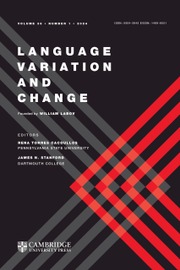Article contents
BE variation in Sri Lankan English
Published online by Cambridge University Press: 03 May 2005
Abstract
The focus of this article is zero copula use in Sri Lankan English speech. Zero copula use has been at the heart of variationist studies, but has received little attention in New English studies because of its limited use in these varieties. In this article I look at zero copula in Sri Lankan English to determine whether the patterns of use parallel those of AAVE, Caribbean Creoles, or other copula studies on varieties of English including New Englishes. The theoretical issue raised in this article is whether zero copula use in Sri Lankan English can be seen as both a creole-like feature and an optional syntactic feature of those who use English a lot, but for whom it is not a native language, or as a substratal influence in language shift. The variable findings for present tense BE demonstrate that speakers of Sri Lankan English make only limited use of BE absence. BE absence appears to be optional in certain environments where Standard English would require the are copula/auxiliary. Zero copula use in Sri Lankan English speech is especially interesting because Sri Lankan English emerged from an educational background and not from a creole setting. However, the linguistic data for zero copula use in Sri Lankan English suggests that the type of complement and the preceding phonological environment play a significant role on zero copula use, which is comparable to that of other varieties of English, focusing on the study of BE absence.A shorter version of this article was presented under a different title at the Triangle Colloquium on Literature and Linguistics held at the University of Sheffield, UK on September 30, 2000. I wish to gratefully acknowledge the excellent comments and insights provided by the two journal reviewers on earlier drafts of this article. Any shortcomings that exist are my own. I would like to dedicate this work to Dr. Anthea Fraser Gupta (University of Leeds) and Prof. Siromi Fernando (University of Colombo).
Information
- Type
- Research Article
- Information
- Copyright
- © 2005 Cambridge University Press
References
REFERENCES
- 7
- Cited by

